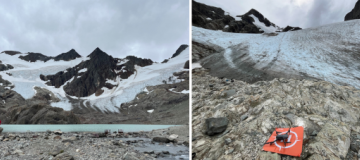
Geological field work in Patagonia
03.10.2024
Many icy moons in the Solar System, such as Ganymede, Europa, and Enceladus, display tectonic features that provide insights into the movement and strength of their crusts. These stress-related structures are crucial for understanding the internal processes of these moons and have implications for astrobiology. Glaciers on Earth undergo similar deformation and serve as valuable models for studying these icy bodies. Despite differences in how they form, their structural similarities allow us to estimate and predict deformation on icy moons at different scales.

The EVIDENCE project seeks to study and compare these tectonic features on icy moons using a multi-scale approach that involves remote sensing and field surveys. The project focuses on three glaciers in the Southern Patagonia Ice Field, located north of Ushuaia, where fieldwork was carried out to measure and analyze structural data. These findings are currently being compared with the tectonic features observed on icy moons to identify common deformation patterns. This project will advance our understanding of tectonics on icy surfaces and contribute to the preparation for future planetary missions.
The first results were presented during the Europlanet Science Congress, which took place from September 8th to 13th in Berlin. Our researcher Riccardo Pozzobon of the Department of Geosciences of the University of Padua participated in the campaign as co-PI together with the PI Costanza Rossi from INAF-Osservatorio di Padova, Mateo Martini and Eliseo Flores. The activities were carried out in the framework of Europlanet Research Infrastructure 2024. In this video some stunning views of the fieldwork!
Europlanet 2024 RI has received funding from the European Union's Horizon 2020 research and innovation programme under grant agreement No 871149 |





